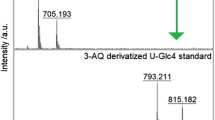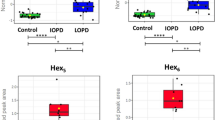Abstract
A high performance liquid chromatography method, adapted from an established urinary sugars method, has been developed for the analysis of a tetraglucose oligomer (Glc4) in urine. Pompe disease results from defects in the activity of lysosomal acid α-glucosidase (GAA) with patients typically excreting increased amounts of Glc4. Rapid determination of GAA in dried blood spots is now possible. However, enzymatic analysis is unable to discriminate between patients with Pompe disease and those individuals harbouring pseudo deficiency mutations. This method was able to quantify Glc4 levels in all patients analysed with an established diagnosis of Pompe disease, and all controls analysed had Glc4 levels below the limit of detection for this method. Importantly the method was able to discriminate between an individual known to harbour a pseudo Pompe mutation and patients with Pompe disease, providing a useful supporting test to enzymatic analysis. Sequential measurement of urinary Glc4 has been proposed to monitor the effects of enzyme replacement therapy (ERT). We observed a clear decrease in Glc4 levels following commencement of treatment in three patients studied. Additionally, raised levels of Glc4 were observed in patients with glycogen storage disease (GSD) type Ia and type III suggesting that this method may have applications in other GSDs.


Similar content being viewed by others
Abbreviations
- C5 :
-
Cellopentaose
- CRIM:
-
Cross-reactive immunologic material
- ERT:
-
Enzyme replacement therapy
- GAA:
-
Acid alpha glucosidase
- Glc4 :
-
Glucose tetrasaccharide
- GSD:
-
Glycogen storage diseases
- Hex4 :
-
Hexose tetrasaccharides
- HPLC-ECD:
-
High performance liquid chromatography with electrochemical detection
References
An Y, Young SP, Hillman SL, Van Hove JLK, Chen Y-T et al (2000) Liquid chromatographic assay for a glucose tetrasaccharide, a putative biomarker for the diagnosis of Pompe disease. Anal Biochem 287(1):136–143
An Y, Young SP, Kishnani PS, Millington DS, Amalfitano A, Corzo D, Chen Y-T (2005) Glucose tetrasaccharide as a biomarker for monitoring the therapeutic response to enzyme replacement therapy for Pompe disease. Mol Genet Metab 85(4):247–254
Ausems M et al. (1999) Frequency of glycogen storage disease type II in the Netherlands: implications for diagnosis and genetic counselling. Eur J Hum Genet 7:713–716
Baldwin RP (1999) Electrochemical determination of carbohydrates: enzyme electrodes and amperometric detection in liquid chromatography and capillary electrophoresis. J Pharm Biomed Anal 19(1–2):69–81
Chamoles NA et al (2004) Glycogen storage disease type II: enzymatic screening in dried blood spots on filter paper. Clin Chim Acta 347(1–2):97–102
Diggelen OP et al (2009) Enzyme analysis for Pompe disease in leukocytes; superior results with natural substrate compared with artificial substrates. J Inherit Metab Dis 32(3):416–423
Dionex (2000) Technical note 20: analysis of carbohydrates by high performance anion exchange chromatography with pulsed amperometric detection (HPAE-PAD). http://www.dionex.com/en-us/webdocs/5023-TN20.pdf. Accessed May 2011
Ersser RS (1979) The identity and origin of oligosaccharides present in the faeces and urine of sick infants. Clin Chim Acta 97(2–3):225–237
Kishnani PS, Hwu W-L, Mandel H, Nicolino M, Yong F et al (2006) A retrospective, multinational, multicenter study on the natural history of infantile-onset Pompe disease. J Pediatr 148(5):671–676, e2
Lennartson G et al (1976) Quantitation of a urinary tetrasaccharide by gas chromatography and mass spectrometry. Biol Mass Spectrom 3(2):51–54
Martiniuk F, Chen A, Mack A, Arvanitopoulos E, Chen Y et al (1998) Carrier frequency for glycogen storage disease type II in New York and estimates of affected individuals born with the disease. Am J Med Genet 79(1):69–72
Schoser B, Hill V, Raben N (2008) Therapeutic approaches in glycogen storage disease type II/Pompe sisease. Neurotherapeutics 5(4):569–578
Scriver CR et al. (2000) The metabolic and molecular bases of inherited disease, 8th ed. McGraw-Hill, New York
Van den Hout JMP et al (2004) Long-term intravenous treatment of Pompe disease with recombinant human {alpha}-glucosidase from milk. Pediatrics 113(5):e448–e457
Winchester B et al (2008) Methods for a prompt and reliable laboratory diagnosis of Pompe disease: report from an international consensus meeting. Mol Genet Metab 93(3):275–281
Winkel LPF et al (2005) The natural course of non-classic Pompe’s disease; a review of 225 published cases. J Neurol 252(8):875–884
Young SP, Stevens RD, An Y, Chen Y-T, Millington DS (2003) Analysis of a glucose tetrasaccharide elevated in Pompe disease by stable isotope dilution-electrospray ionization tandem mass spectrometry. Anal Biochem 316(2):175–180
Young SP, Zhang H, Corzo D, Thurberg BL, Bali D et al (2009) Long-term monitoring of patients with infantile-onset Pompe disease on enzyme replacement therapy using a urinary glucose tetrasaccharide biomarker. Genet Med 11(7):536–541
Acknowledgements
We are grateful to the Child Health Research Action Trust and Great Ormond Street Children’s Charity for funding this work.
Author information
Authors and Affiliations
Corresponding author
Additional information
Communicated by: Ed Wraith
Competing interest: None declared.
Victoria Manwaring and Helen Prunty contributed equally to this study.
An erratum to this article can be found at http://dx.doi.org/10.1007/s10545-011-9383-8.
Rights and permissions
About this article
Cite this article
Manwaring, V., Prunty, H., Bainbridge, K. et al. Urine analysis of glucose tetrasaccharide by HPLC; a useful marker for the investigation of patients with Pompe and other glycogen storage diseases. J Inherit Metab Dis 35, 311–316 (2012). https://doi.org/10.1007/s10545-011-9360-2
Received:
Revised:
Accepted:
Published:
Issue Date:
DOI: https://doi.org/10.1007/s10545-011-9360-2




